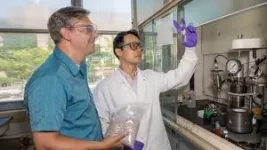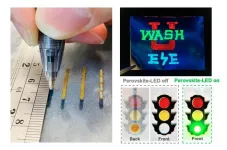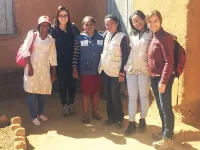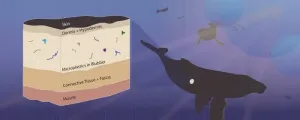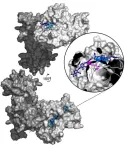(Press-News.org) (Santa Barbara, Calif.) — Previous research has revealed that the Apolipoprotein-ε4 (APOE-ε4) allele increases the risk for a variety of diseases in aging populations, specifically Alzheimer’s and cardiovascular disease. And yet, despite the negative effects of this genetic variant, it remains prevalent in approximately 20% of the human population. In a quest to determine how this negative allele is surviving natural selection, a group of researchers have discovered that the APOE-ε4 allele is associated with higher fertility in women.
In a new paper released in Science Advances, researchers including UC Santa Barbara anthropologist Michael Gurven worked alongside the Tsimane community in Bolivia, a forager-horticultural society, to study the effects of the allele through an evolutionary lens.
Senior author Gurven, and lead author Benjamin Trumble, an associate professor of evolutionary anthropology at Arizona State University’s School of Human Evolution and Social Change, headed to the Bolivian Amazon lowlands where the Tsimane live. Co-directors of the Tsimane Health and Life History Project (also co-directed by Hillard Kaplan and Jonathan Stieglitz), they have a longstanding relationship with the Tsimane to collect demographic and biomedical data alongside the provisioning of medical care — a relationship that has been in effect for over two decades. The Tsimane Health and Life History Project is a large interdisciplinary team effort funded by the National Institute on Aging, combining U.S. and Bolivian anthropologists, clinicians and medical specialists.
With more than 17,000 people living across 90 villages, the Tsimanes’ agrarian lifestyle is more similar to human life prior to the Industrial Revolution than modern cities, offering a unique glimpse into health and aging without the influences of modern day amenities.
“What we do is try to understand what human health was like prior to industrialization,” Trumble explained.
“For 99% of human history, we were hunter-gatherers. The world we're living in today is really weird. It's this built environment that we've created that's very different from what it was throughout most of human evolution.”
For this particular study, the researchers collected data from 795 Tsimane women, ranging in age from 13 to 90 years old. The team of researchers not only retrieved genetic data to determine which alleles are prevalent for each individual, but also detailed reproductive histories that provide information about their fertility, including age of first birth, how long between births and the total number of live births.
They discovered that Tsimane women with the presence of one APOE-ε4 allele had an increase of 0.5 births, compared to those without the APOE-ε4 allele. The number of live births increased even more when there was the presence of two copies of the APOE-ε4 allele, where these women had an average of two more live births compared to those without this specific allele.
“What we found was that women with the APOE-ε4 allele began reproducing almost a year earlier and they had shorter interbirth intervals,” Trumble explained. “Those two things combined allow them to have about half an additional child if they have one copy or two additional children if they have two copies.”
This advantageous effect on fertility could help to explain how an allele that has such a negative impact in one’s later life through the increased chances of developing Alzheimer’s or cardiovascular disease has not been weeded out by natural selection — the advantages take place in one’s early to mid-life years, and therefore are passed along to their offspring.
“Genes that are associated with diseases that occur after reproduction is complete, are thought to be invisible to selection, in what is called ‘selection’s shadow,’” Gurven said. “If those same genes provide benefits to your fitness earlier in life, it would be even harder for selection to weed out those genes.”
Other, smaller studies have shown other advantageous aspects of the APOE-ε4 allele, including that children in Brazil are able to handle environmental pathogens and parasites, such as giardia, better than those without the allele, which resulted in better cognitive functions and higher growth rates.
This study builds on prior work showing other potential benefits of APOE-ε4 in the rural high-infection environment of the Tsimane. In one, the researchers showed that Tsimane APOE-ε4 carriers showed lower levels of inflammation when uninfected, but maintained higher blood lipid levels that buffer costs of immune activation during infection. In another, they showed that APOE-ε4 carriers were protected from cognitive declines, but only those who had experienced infection.
Even with these benefits of the APOE-ε4 allele that have been discovered, there is still the major deleterious effect of the increased risk of Alzheimer’s and cardiovascular disease in the later stages of life.
Interestingly, this negative effect of the allele is mostly seen in Westernized nations. The Tsimane, for instance, have the lowest rates of dementia and Alzheimer’s in the world, as discovered by the large interdisciplinary team last year. This is despite having the same 20% prevalence of the APOE-ε4 allele in their population.
What can this mean for understanding and treating the negative effects of the allele in areas affected the most?
“We need to think outside the box and move beyond our focus on ‘this allele causes X disease’ and that's just how it is. Instead, we need to take a step back and ask, what about in different environments? What about in the environments in which humans evolved?” said Trumble.
“When we see that APOE-ε4 has different effects on our health in different environments, we need to think about the larger context in which those genes first evolved and are later maintained, like how our genes might hurt us in some settings, but help us in others,” said Gurven. “If we could figure out a way to mimic the conditions where APOE-ε4 doesn’t harm us, but may even help, that could launch a new path forward for disease prevention.”
END
New research shows genetic mutation known for Alzheimer’s disease is associated with higher fertility in women
2023-08-10
ELSE PRESS RELEASES FROM THIS DATE:
Trinity research looks to Latin America for clues on healthy brain ageing
2023-08-10
Researchers at Trinity College Dublin study the factors influencing healthy brain ageing in Latin American and Caribbean (LAC) countries and find the lessons learned there, can also be applied to home.
Ageing is not a uniform process across the globe. Most research into cognitive and functional ageing has been conducted in the US and Europe, in high-income settings. Researchers from the Global Brain Health Institute (GBHI) at Trinity College are filling the knowledge gap that exists for Latin American populations on the factors ...
Transplant recipients experience limited protection with primary COVID-19 vaccination series, but third dose boosts response
2023-08-10
Key Takeaways
Lung and heart transplant recipients experienced diminished and delayed antibody responses to the first two COVID-19 mRNA vaccine doses, but most developed stronger responses following a third dose
A third dose also boosted cross-protection against SARS-CoV-2 viral variants
For lung and heart transplant recipients, vaccine doses beyond the third dose are likely important for maintaining immunity
BOSTON – Transplant recipients must take life-long immunosuppressive medications to prevent rejection, but these drugs ...
Department of Energy announces $11 million for exploratory research in extreme-scale science
2023-08-10
WASHINGTON, D.C. - Today, the U.S. Department of Energy (DOE) announced $11 million in funding for 15 projects in exploratory research for extreme-scale science that will leverage emerging trends and advances in high-end computing, massive datasets, scientific machine learning, artificial intelligence, and novel computing architectures.
“There is a wide expanse of exciting opportunities as we reach beyond exascale computing,” said Ceren Susut, DOE Acting Associate Director of Science for Advanced Scientific Computing Research. “These ...
Simple ballpoint pen can write custom LEDs
2023-08-10
Researchers working with Chuan Wang, an associate professor of electrical and systems engineering at the McKelvey School of Engineering at Washington University in St. Louis, have developed ink pens that allow individuals to handwrite flexible, stretchable optoelectronic devices on everyday materials including paper, textiles, rubber, plastics and 3D objects.
In a paper published Aug. 7 in Nature Photonics, the team reports their simple and versatile fabrication approach to allow anyone to make a custom light-emitting diode (LED) or photodetector ...
Community health program boosts child vaccinations in remote areas of Madagascar
2023-08-10
URBANA, Ill. – Madagascar is one of the poorest countries in the world and access to health care is limited for many people. Childhood vaccinations are a crucial component of preventative care, but vaccination rates remain below the World Health Organization’s goal of reaching 95% of children. A new study from the University of Illinois Urbana-Champaign examines the effectiveness of a health intervention program that enlists community-based health workers to promote child vaccination uptake.
“Childhood vaccinations are a cost-effective investment that can have large ripple effects. Vaccines can reduce child mortality ...
Athletes have no reason to be concerned by their COVID-19 vaccine this winter but timing matters
2023-08-10
It is now almost a rule of thumb: As soon as an athlete falls to the ground with a sudden cardiac arrest, social media is awash with claims that COVID-19 vaccinations are to blame. This was the case with English footballer Charlie Wyke, cyclist Sonny Colbrelli and, most recently, with college basketballer, and son of LeBron, Bronny James. In the view of Harald Jorstad, Sports Cardiologist at Amsterdam UMC, there is no evidence to support these claims, but timing of the vaccination can be structured to not ...
Microplastics found embedded in tissues of whales and dolphins
2023-08-10
BEAUFORT, N.C. – Microscopic plastic particles have been found in the fats and lungs of two-thirds of the marine mammals in a graduate student’s study of ocean microplastics. The presence of polymer particles and fibers in these animals suggests that microplastics can travel out of the digestive tract and lodge in the tissues.
The study, slated for the Oct. 15 edition of Environmental Pollution, appeared online this week.
Harms that embedded microplastics might cause to marine mammals are yet to be determined, ...
Tool finds bias in state-of-the-art generative AI model
2023-08-10
Text-to-image (T2I) generative artificial intelligence tools are increasingly powerful and widespread tools that can create nearly any image based on just a few inputted words. T2I generative AI can create convincingly realistic photos and videos which are being used more and more for a multitude of purposes, from art to political campaigning.
However, the algorithmic models that power these tools are trained on data from humans, and can replicate human biases in the images they produce, such as biases around gender and skin tone. These biases can harm marginalized populations, reinforcing stereotypes and potentially leading to discrimination.
To address these implicit biases, ...
Chloride Ions From Seawater Eyed As Possible Lithium Replacement In Batteries of the Future
2023-08-10
Sodium, Potassium and zinc have all been promising contenders for lithium’s place in rechargeable batteries of the future, but researchers at Worcester Polytechnic Institute (WPI) have added an unusual and more abundant competitor to the mix: chloride, the richest negatively charged ions in seawater.
Xiaowei Teng, the James H. Manning professor of Chemical Engineering at WPI, has discovered a new redox chemistry empowered by chloride ions for the development of seawater green batteries.
Modern lithium-ion batteries used in various applications, including electric vehicles, can be problematic for grid storage, given their ...
Mechanism underlying bacterial resistance to the antibiotic albicidin revealed
2023-08-10
A new analysis shows that infectious bacteria exposed to the antibiotic albicidin rapidly develop up to a 1,000-fold increase in resistance via a gene amplification mechanism. Mareike Saathoff of Freie Universität Berlin, Germany, and colleagues present these findings August 10th in the open access journal PLOS Biology.
Bacterial resistance to antibiotics is a growing problem associated with millions of deaths around the world every year. Understanding how bacteria evolve resistance is key to developing more effective antibiotics and strategies for using them.
In recent years, albicidin has emerged as a promising antibiotic capable of killing a wide range of bacterial species ...

